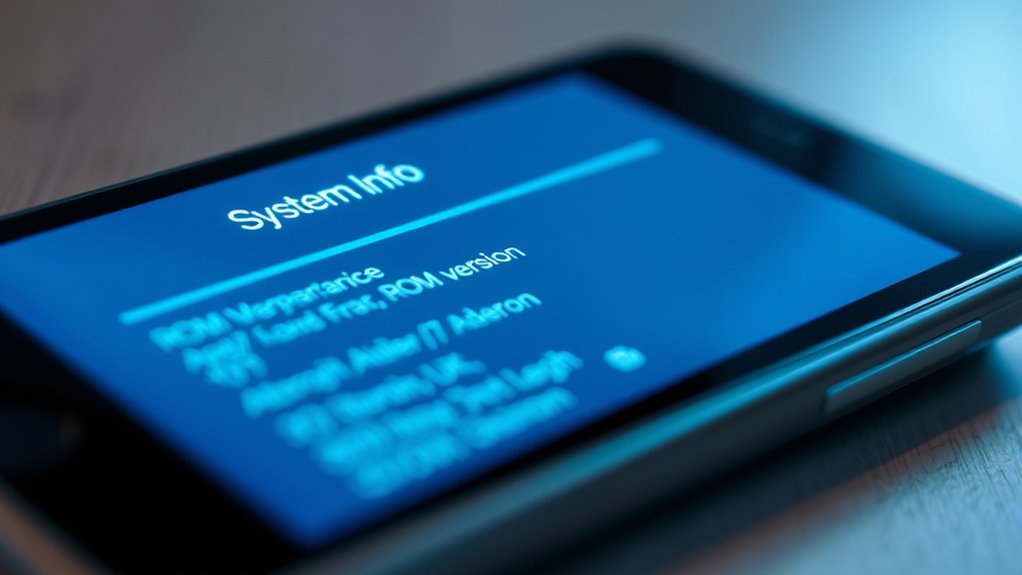To identify your machine’s ROM version, start by checking your device’s system information or BIOS/UEFI settings. On Windows, open System Information or run command prompt commands like “wmic bios get smbiosbiosversion.” On macOS, access “About This Mac” or use Terminal commands. For smartphones, look in Settings under About Phone. On Linux, use commands like `cat /proc/version` or `dmidecode`. If you’re curious about the details, exploring these steps can reveal exactly what you need.
Key Takeaways
- Use system information tools like “msinfo32” on Windows or “System Report” on macOS to find firmware details.
- Run command line commands such as “wmic bios get smbiosbiosversion” (Windows) or “cat /proc/version” (Linux) for version info.
- Access BIOS/UEFI during startup (e.g., F2, Delete) to view firmware or ROM version directly.
- Check device settings or about sections on Android and iOS devices for firmware or software version details.
- For Raspberry Pi or similar devices, use terminal commands like “dmidecode -s system-version” to identify ROM version.
Checking ROM Version on Windows Computers
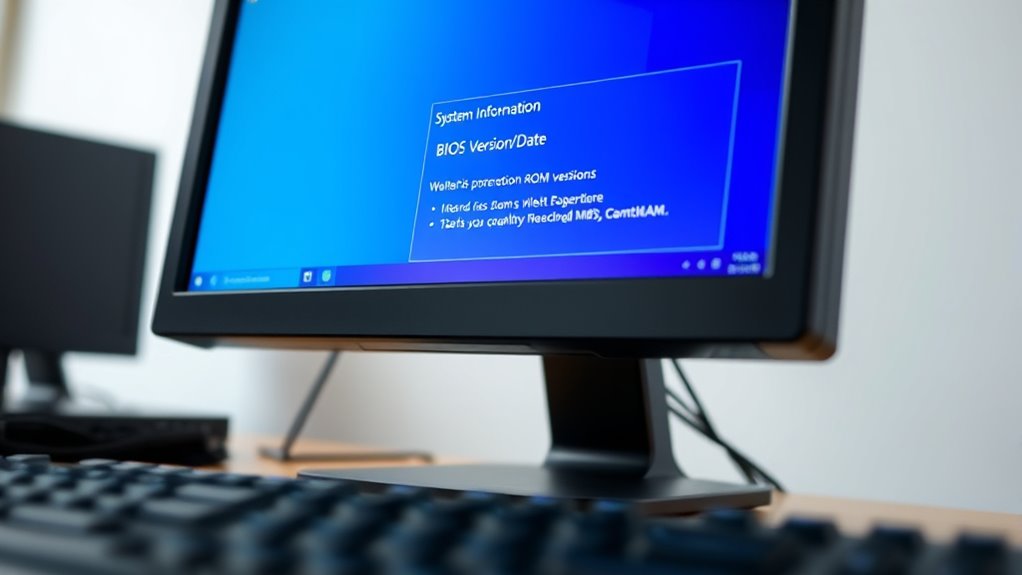
To check your ROM version on a Windows computer, you can use the System Information tool or Command Prompt. These methods help you verify firmware compatibility and assist with hardware identification. First, open the System Information app by typing “msinfo32” into the search bar. Look for the BIOS Version/Date entry to find your ROM version. Alternatively, open Command Prompt and type “wmic bios get smbiosbiosversion” to display the firmware version directly. Knowing your ROM version is pivotal for ensuring compatibility with updates or troubleshooting hardware issues. It is also useful to stay informed about AI-driven security systems, which can provide advanced threat detection for your hardware. This process provides a quick, reliable way to gather essential system information without additional software.
Finding ROM Details on Macos Devices
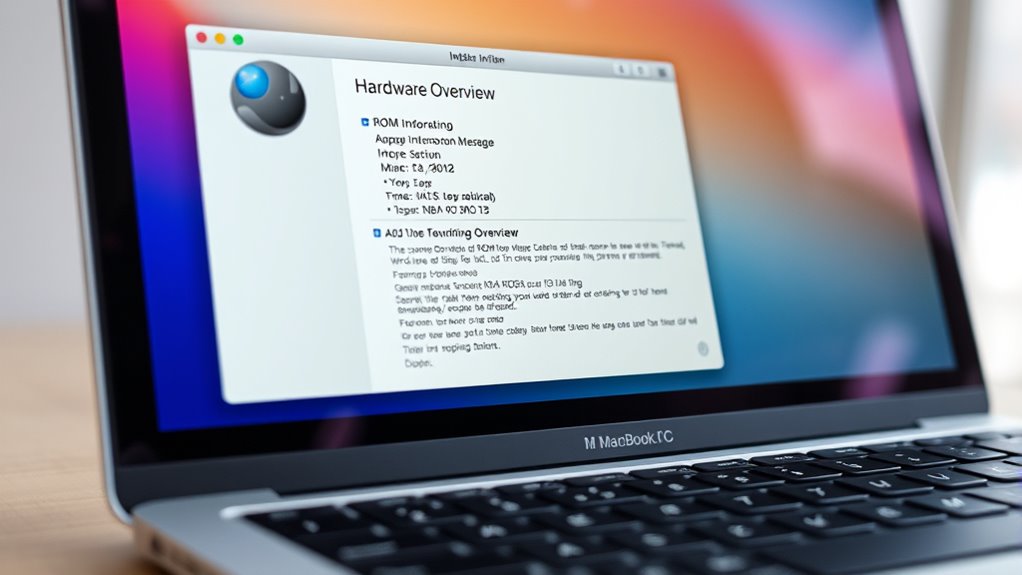
Finding ROM details on macOS devices involves accessing system information through built-in tools. To do this, open the Apple menu and select “About This Mac,” then click “System Report.” Here, you’ll find detailed hardware diagnostics, including firmware information. While macOS doesn’t provide a direct ROM version, the firmware details listed help determine firmware compatibility with software updates and hardware components. This is especially useful for troubleshooting hardware issues or ensuring compatibility with specific peripherals. You can also use Terminal commands like `system_profiler` to gather more detailed system data. Regularly checking these details ensures your device’s firmware remains compatible with the latest updates, helping maintain top performance and hardware diagnostics accuracy. Understanding your device’s firmware can also aid in recognizing updates that improve security and stability.
How to Identify ROM Version on Android Smartphones
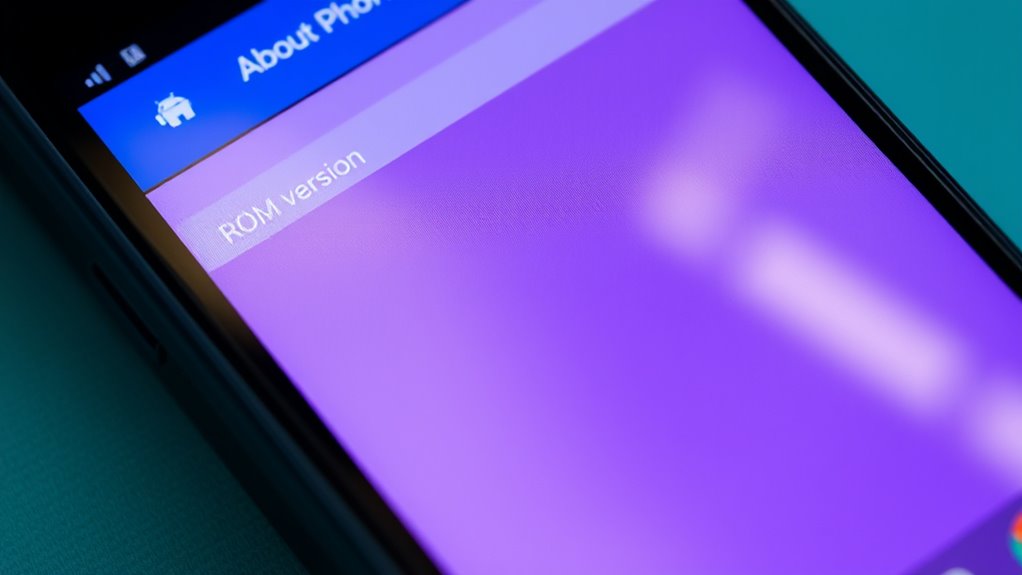
To find your Android smartphone’s ROM version, start by checking the Settings menu, where it’s usually listed under About Phone or Software Information. You can also use a device info app for quick details or dial a specific code to access system info directly. These simple methods help you identify your device’s ROM version quickly and accurately. Additionally, understanding your device’s software details can improve troubleshooting and ensure compatibility with updates.
Check Settings Menu
Accessing your device’s settings menu is the quickest way to find your Android smartphone’s ROM version. Follow these steps:
- Open the Settings app on your device.
- Scroll down and tap on “About Phone” or “About Device.”
- Look for “Software Information” or a similar section.
- Find the “Android Version” or “Build Number,” which indicates your ROM version.
- Regularly checking your ROM version can help you stay informed about device updates and compatibility.
Knowing this helps you determine if a firmware update is needed and whether your device is compatible with new features. Checking this regularly ensures your device stays secure and performs at its best. Remember, ROM versions can influence device compatibility, so keeping track of updates is essential for seamless operation. This method is quick and straightforward, avoiding the need for third-party apps or additional tools.
Use Device Info App
After checking your device’s settings, you can also use a dedicated app like Device Info to quickly identify your ROM version. This app provides detailed information about your device’s firmware, including the OS build number and software version, which are essential for verifying firmware compatibility. Using Device Info simplifies hardware diagnostics by offering insights into your device’s hardware specifications alongside software details. It’s especially useful if you need to confirm whether your device runs the latest firmware or if an update is necessary. The app’s user-friendly interface allows you to access all this information in one place, making it easier to troubleshoot or prepare for compatibility checks. Overall, Device Info streamlines the process of identifying your ROM version accurately and efficiently, which is crucial for supporting emotional well-being during device updates or troubleshooting.
Dial Code Method
Many Android devices allow you to quickly check your ROM version by dialing a specific code on your phone’s keypad. This method is useful for confirming your current ROM before engaging in custom ROM development or ROM flashing procedures. To do this:
- Dial *#*#1234#*#* or *#*#1111#*#* (varies by device).
- Wait for the notification or screen displaying your ROM version.
- Note the version info for reference.
- Use this information to determine compatibility for custom ROMs or updates.
- Knowing your ROM version helps in maintaining device security and stability.
This simple dial code method conserves time compared to other tools and helps ensure you’re working with the correct ROM version. It’s a quick step that can streamline your process when flashing or troubleshooting your device.
Locating ROM Information on Ios Devices
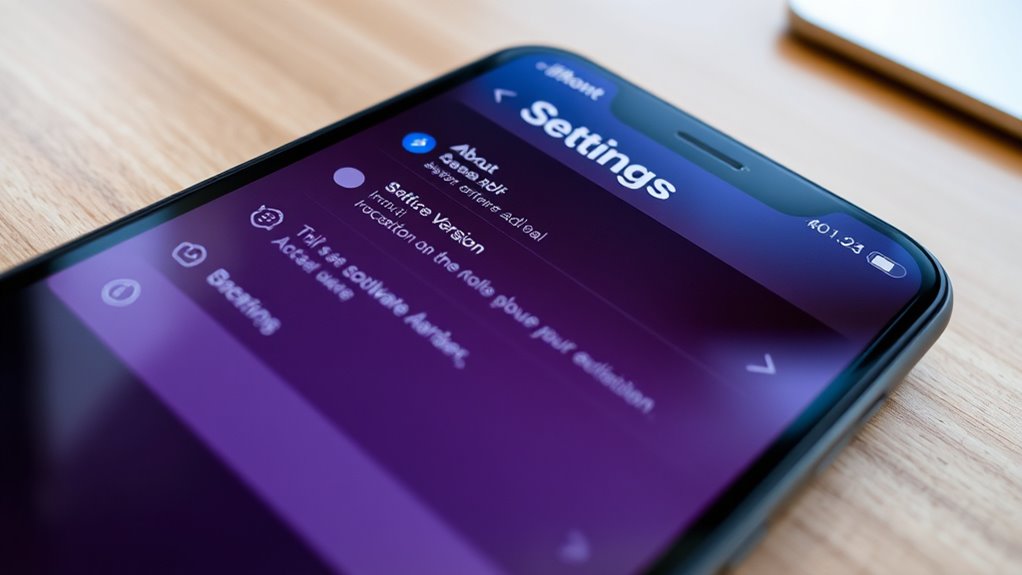
To find your iOS device’s ROM information, start by opening the Settings menu. Then, navigate to the About section to view details about your device. This quick step reveals the key information you need about your device’s firmware version. Additionally, understanding your device’s firmware version can help you determine compatibility with software updates and troubleshoot issues effectively.
Accessing Settings Menu
Accessing the settings menu on your iOS device is straightforward and essential for locating your ROM version. Follow these steps to find the information you need:
- Tap the Settings app on your home screen.
- Scroll down and select General.
- Tap About to access device details.
- Look for the Software Version, which indicates your firmware. This info helps determine hardware compatibility and whether firmware updates are available.
- Being aware of your device’s software update status can help ensure your system is optimized and secure.
Checking About Section
After opening the Settings menu and exploring to the General section, tap on “About” to view detailed information about your device. Here, you’ll find your current firmware version, which is essential for checking firmware security and ensuring version compatibility with apps and updates. The “About” section displays your model number, serial number, and software version, giving you a clear snapshot of your device’s current ROM. Knowing this helps you determine if you need to update or if your device’s firmware is secure against vulnerabilities. It’s the quickest way to confirm your device’s ROM version without needing additional tools. Keep an eye on the software version to stay compatible with the latest features and security patches. Firmware security is vital for protecting your device from potential threats.
Discovering ROM Version on Linux Systems
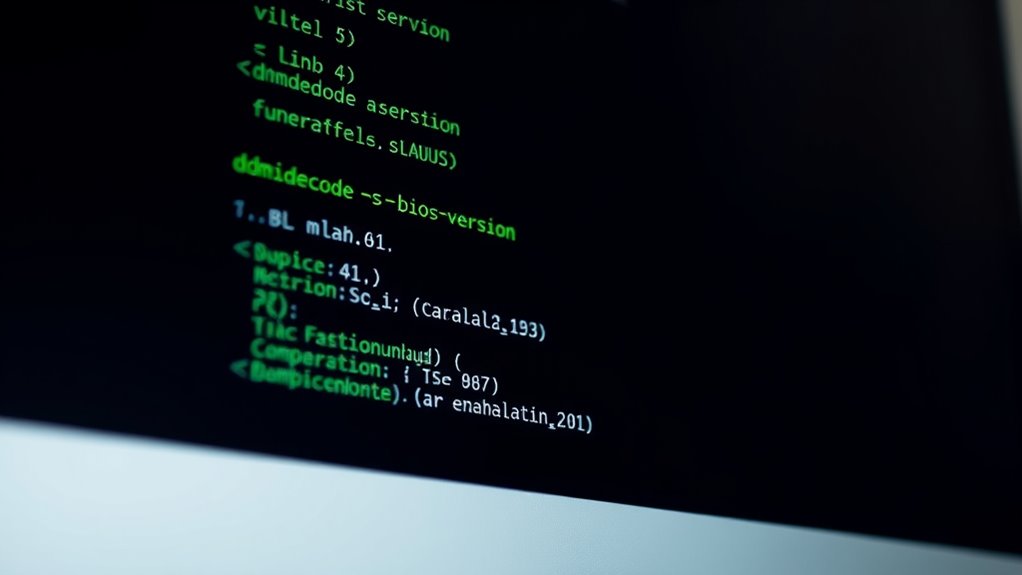
You are trained on data up to October 2023. To ensure your device’s optimal performance, it’s helpful to know how to identify your ROM version on Linux systems.
Viewing ROM Data on Raspberry Pi and Single-Board Computers
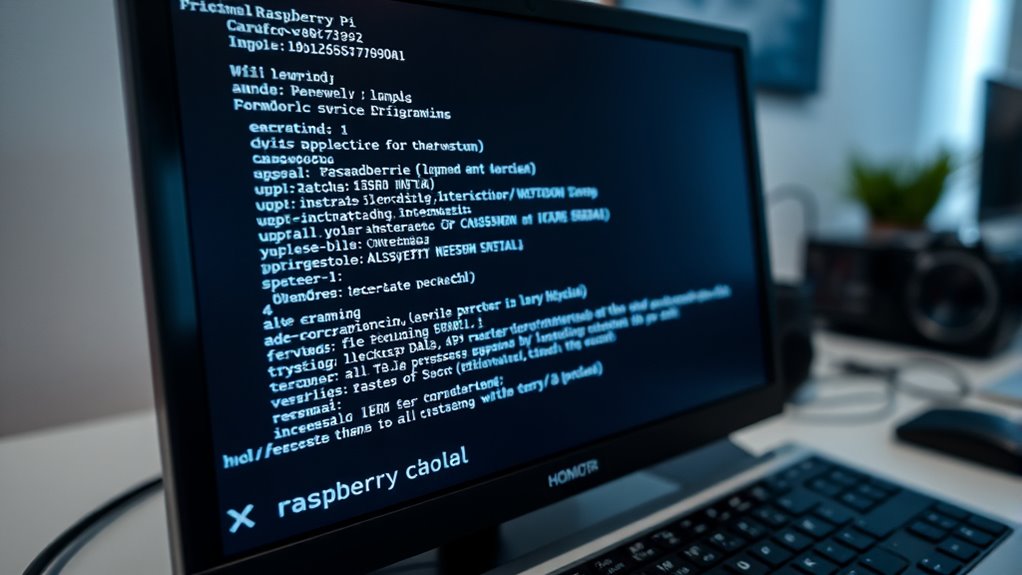
Viewing ROM data on Raspberry Pi and other single-board computers involves directly inspecting the firmware information stored in their hardware components. To do this, you can access the system logs or firmware files that reveal your device’s current ROM version. This process helps determine if your firmware is up to date or needs a firmware update for improved system compatibility. Unlike traditional PCs, these devices often store firmware details in specific files or boot logs, making it easier to verify without complex commands. Checking ROM data ensures your device runs the latest firmware, essential for stability and security. By understanding your hardware’s firmware version, you can better assess whether a firmware update is necessary to enhance performance or address compatibility issues.
Using Command Line Tools to Check ROM Version
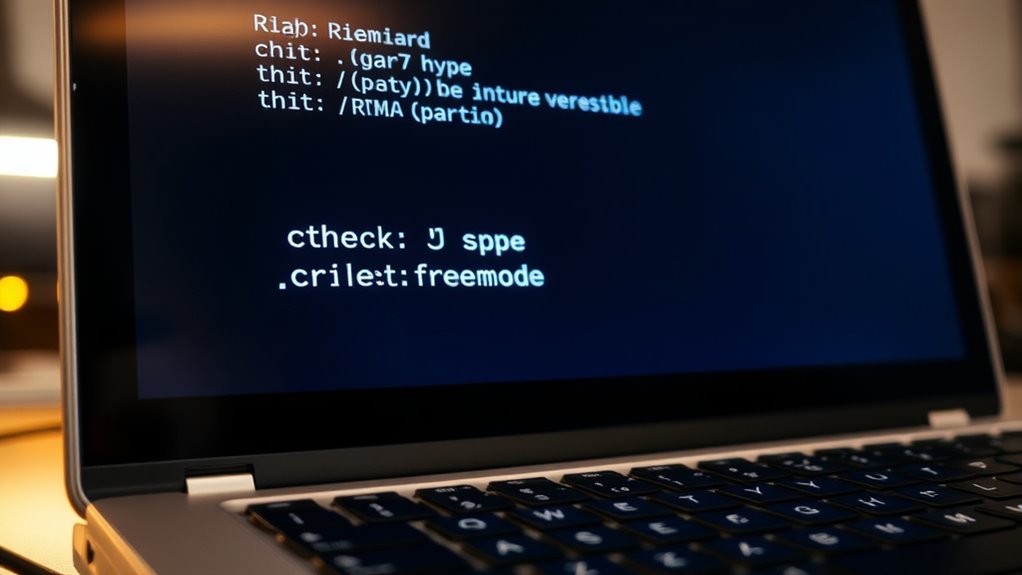
Are you wondering how to quickly find your device’s ROM version? Using command line tools makes this straightforward. Here’s what you should do:
Easily identify your device’s ROM version with simple command line checks.
- Open your terminal or command prompt.
- Enter commands like `cat /proc/version` or `dmidecode -s system-version`. These reveal your current ROM version.
- Review the output for version numbers or identifiers.
- Use this info to check firmware updates or hardware compatibility.
Accessing ROM Version via BIOS or UEFI Settings

Want to find your device’s ROM version without relying on command line tools? Accessing it through BIOS or UEFI settings is straightforward. Restart your computer and enter the BIOS/UEFI menu by pressing a designated key (usually F2, F10, or Delete). Navigate to the system information or firmware section. Here, you’ll see details like the firmware version, which indicates your ROM version. This method helps guarantee your firmware is compatible with hardware updates or firmware updates. Use the table below for quick reference:
| Step | Action | Result |
|---|---|---|
| 1 | Restart your device | Enter BIOS/UEFI via key press |
| 2 | Navigate to system info | Find firmware version |
| 3 | Note the ROM version | Check for updates or compatibility |
| 4 | Exit BIOS/UEFI | Save changes if needed |
| 5 | Verify version | Confirm firmware status |
This process offers a clear way to verify your ROM version directly from your system settings.
Tips for Troubleshooting and Updating Your ROM Version
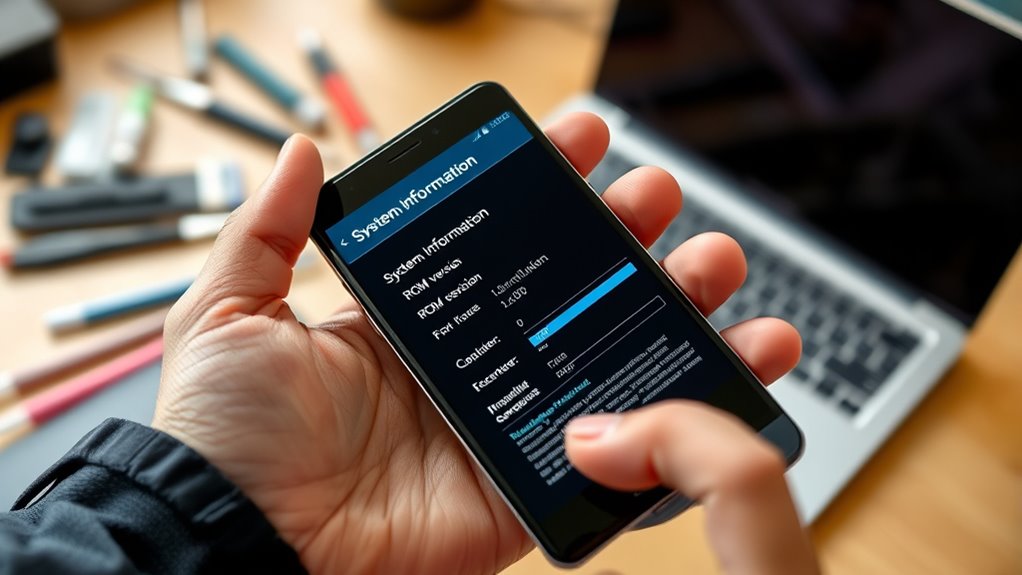
If you’ve checked your ROM version through BIOS or UEFI and suspect it needs an update, troubleshooting can help identify underlying issues. Start by verifying if your firmware updates are available from your manufacturer’s website. Next, check for compatibility issues that might prevent proper updates or cause system instability. Then, make sure your power supply is stable during updates to avoid corruption. Finally, consider resetting your BIOS or UEFI settings to default, as misconfigurations can interfere with firmware updates. Remember, applying the correct firmware updates is essential for system stability and security. If issues persist, consult manufacturer support or forums for specific guidance. Proper troubleshooting ensures your ROM version stays current and your system runs smoothly.
Frequently Asked Questions
Can I Upgrade My Machine’S ROM Version Safely?
You can upgrade your machine’s ROM version safely if you follow proper update guidelines and guarantee firmware compatibility. First, check the manufacturer’s instructions and verify that the new firmware works with your specific model. Avoid rushing the process, and back up your data. If you’re unsure, consult technical support or a professional to prevent potential issues. Properly following these steps helps ensure a smooth, safe upgrade.
How Do ROM Versions Affect Device Performance?
Think of your device’s ROM version as the foundation of a house—when it’s up-to-date, everything fits perfectly. The firmware compatibility guarantees your device runs smoothly, and hardware integration remains seamless. Outdated ROMs can cause performance issues, slowdowns, or crashes. Keeping your ROM current optimizes device performance, fixes bugs, and improves security. To maintain peak performance, stay informed about your ROM version and update it when necessary.
What Are the Risks of Flashing a Different ROM?
Flashing a different ROM can boost performance but comes with risks. You might face hardware compatibility issues, causing your device to malfunction or become unstable. There’s also a chance of voiding your warranty, meaning manufacturers may refuse repairs if problems arise. Always verify the new ROM matches your device’s specifications and consider the potential consequences before proceeding, as incorrect flashing can brick your device or lead to data loss.
How Often Should I Check for ROM Updates?
You should check for ROM updates regularly to guarantee firmware compatibility and peak performance. Setting a consistent update scheduling, like monthly or quarterly, helps you stay current with the latest security patches and features. Keep an eye on official sources or device notifications. By doing this, you prevent potential issues caused by outdated firmware and guarantee your machine runs smoothly with the latest improvements.
Are There Tools to Compare Different ROM Versions?
Think of comparing ROM versions like checking different editions of a book. You need tools for firmware comparison that highlight differences clearly. These tools help with version control, making it easier to see updates or changes between firmware versions. Using specialized software, you can quickly identify differences, ensuring your system stays up-to-date and secure. This process simplifies managing multiple firmware versions, giving you confidence in your device’s stability and performance.
Conclusion
Now that you know how to find your machine’s ROM version, you can approach updates and troubleshooting with confidence. Think of it like tuning a fine instrument—you’ll guarantee everything runs smoothly and efficiently. Regularly checking your ROM is like giving your device a health check-up, helping you stay ahead of potential issues. Stay proactive, and your device will perform like a well-oiled machine, ready to meet whatever tasks you throw at it.
